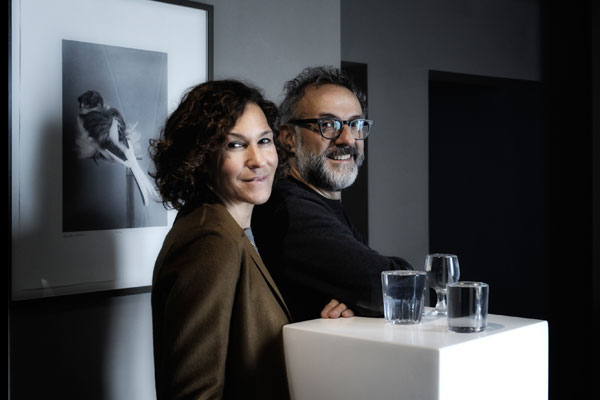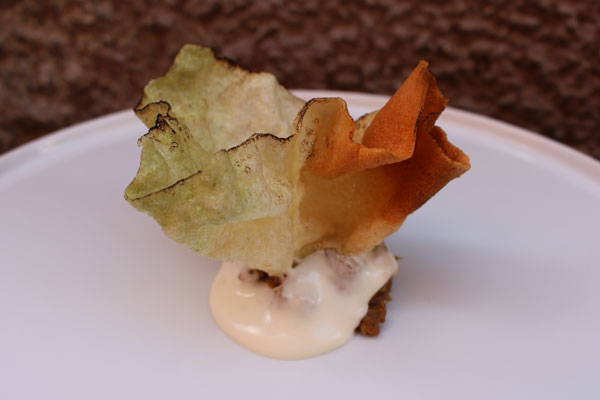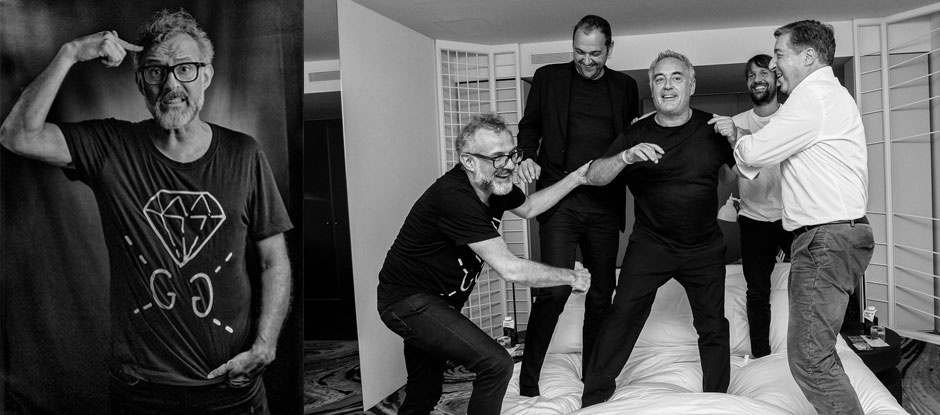Header images: Massimo Bottura (left) and pictured with Daniel Humm, Ferran Adrià, René Redzepi and Joan Roca (images: © Gianni Villa)
In the second of our Best and Beyond series, presented by Miele, we spoke to Massimo Bottura, whose restaurant Osteria Francescana topped The World's 50 Best Restaurants in 2016.
Five of the world’s best chefs are bouncing up and down on a king-size bed like children, swinging fluffy white pillows back and forth in a playful bid to knock each other down. It’s hard to believe that, just a few minutes earlier, the quintet of game-changing cooks stood stiffly at the foot of the bed, wondering what to make of the French photographer’s unconventional photo shoot request. But if there’s anyone who can coax a group of grown men into a pillow fight, it’s Massimo Bottura.
The Italian chef, known throughout the restaurant industry for his boundless energy and limitless imagination, is certainly the most hyperactive of the five super-chefs gathered in Barcelona to celebrate the 15th Anniversary of The World’s 50 Best Restaurants, presented by Miele. The group includes René Redzepi, Daniel Humm and Joan Roca, but Bottura is the only one who can persuade Ferran Adrià – the legendary 55-year-old cook who is now more frequently found with his head buried in books in his research lab than in the kitchen – to take off his shoes and start jumping on the bed springs.
Bottura may be light-footed but he’s a heavyweight in the world of gastronomy. With a career spanning over three decades, his restaurant Osteria Francescana in Italy was voted The World’s Best Restaurant last year – an achievement that elicits both pride and gratitude. “Every morning I look in the mirror and I say to myself: you’re so lucky. You’re living such a great life and you have to keep going like that and say thank you every day,” he says.
Osteria Francescana, which nestles in the small historic town of Modena in northern Italy’s Emilia-Romagna region, has firmly held a place in The World’s 50 Best Restaurants list for the last eight years and currently ranks No.2. Bottura has been named Italy’s top chef by Gambero Rosso, the country’s most renowned food rating group, and has won a prestigious Gran Prix de l’Art de la Cuisine from the International Academy of Gastronomy in Paris, among many other accolades.
But to think any of this is down to ‘luck’ is to underestimate the man; Bottura says he achieved his success by taking on challenges day by day. “If you’re alert and you don’t lose yourself in everyday life, you become a better man every day,” he says. His relentless search for greatness has meant that he has had to stay focused through up and downs, but a drive to succeed, a desire to do things differently and a dedication to the community can take you a long way.
Watch the video interview with Massimo Bottura:
The revolution in Italian cuisine
Many chefs and gourmets alike consider Bottura a visionary. From the outset, he chose to revolutionise the cuisine of a country whose food culture is celebrated all over the world; a tradition full of successes but regulated by strict laws. In progressing Italian gastronomy, he has proven that no tradition is too good or too established to be picked apart and he has inspired a whole generation of chefs to do the same. But it’s never been a straightforward journey.
In 1986, Bottura’s brother Paolo convinced 23-year-old Massimo to buy a trattoria in the countryside outside Modena. Since he opened Trattoria del Campazzo – where he applied the French cuisine techniques he learnt from early mentor George Cogny to traditional Italian recipes – Bottura has been guided by a deep-rooted desire to innovate and push forward as many aspects of gastronomy as he can get his hands on. “I'm a contemporary man,” he says. “I always say that in my future, there will always be future. I keep evolving all the time.” And with him, Italian cuisine evolved too.
Emilia-Romagna, the region from where Bottura hails, has a long history deeply intertwined with that of its famous produce. Within a short drive of Osteria Francescana are the Parmigiano Reggiano cheese factories, the farms where the pigs for Prosciutto di Parma ham are reared and the establishments where Tradizionale di Modena balsamic vinegar is prepared. These classic Italian products have one thing in common: their recipes have been religiously protected, revered and never tinkered with for decades. There are no two ways of making Parmesan.
“When I think about my life and the past 31 years of career, I think about an old lady, Lidia Cristoni, who taught me about humility,” says Bottura. Cristoni showed up one day at the door of Trattoria del Campazzo and soon became one of Bottura’s inspirations. In Italy, the best recipe is always your mother’s recipe and Lidia, a real Italian nonna, could prepare the classic dishes to the letter of tradition.
But Bottura was striving to achieve something more and he couldn’t be satisfied with the way Italian cuisine treated its staple recipes: glorifying them and refusing to change a thing. “I always look at the past in a critical way, not in a nostalgic one, to bring the best from the past into the future,” is his motto. He wanted to re-invent traditional Italian dishes to bring them into the 21st century.
As Daniel Humm, chef of Eleven Madison Park in New York, No.1 in The World’s 50 Best Restaurants 2017 list, says: “In a country like Italy, where fine dining has a hard time because Italian food is so big and so strong around the world, to redefine modern Italian cuisine is really inspiring.”
Bottura with Lara Gilmore (image: Paolo Terzi)
The making of the chef and the restaurant
Bottura’s work to push forward the limits of Italian cuisine has been influenced by chefs and food from all around the world. A nine-month visit to New York and an internship at Alain Ducasse’s Le Louis XV in Monte Carlo led to Bottura closing his first restaurant. “Alain gave me this strength of belief in myself because he was believing in me,” says Bottura. “Even now, when I see someone talented and with the right attitude, I push them to stand on their feet and to find their own mark and style.” Trattoria del Campazzo was sold and Osteria Francescana opened in 1995 on a quiet street in Modena.
Eating at Osteria Francescana provides more than a glimpse into Bottura’s soul. Coming from the streets of Modena, where the slow rhythm of life is marked by the periodic ringing of the medieval church bells, diners entering the restaurant are transported into a different world. En route to the dining room, guests walk through a space punctuated by striking pieces of art, from a lemon light bulb to a large disc hanging from the wall that looks like it is crumbling away.
Bottura’s American-born wife and collaborator, the stylish and vibrant Lara Gilmore, is not only the calming foil to his creative storm, but has also been a key artistic influence on the chef. As a result, Osteria Francescana is full of contemporary art and Bottura’s favourite records accompany the dining experience. Art is a form of inspiration that spreads into his recipes too.
Dishes are non-conformist but infectious, designed to trigger feelings and sensations, spreading far beyond the borders of Italy and its culinary mores. Maybe what makes the restaurant – and the chef himself – unique is this simple: he’s all about emotions. Every dish has a story attached to it, unravelling over the course of several bites, or it may be intended to trigger a specific feeling, a moment or a memory. “There are thousands and thousands of restaurants where you can eat incredible food, but very few restaurants where you can go and eat emotions,” says Bottura.
In 2000, Bottura was invited to work in the kitchen of El Bulli in Roses, Spain, with Ferran Adrià. “Everybody looked at Ferran as the master of technique. To me, the most important focus of what he did is freedom. He gave us freedom to express ourselves in any way.” By the time he returned to Modena, Bottura had mustered the courage to take apart some of the most famous recipes from Emilia-Romagna. He did so with his trademark creative flair.
The classic Italian lasagne turned in Bottura’s hands into the futuristic The Crunchy Part of the Lasagne, with triangle-shaped pasta sheets (inspired by a Ferrari’s air jets) accompanied by layers of béchamel and meat ragù. Diners are invited to break the crunchy, homemade pasta triangles with their hands and use them to scoop up the sauces; much like a mischievous young Massimo would try to do when his mother wasn’t looking. .
Under Bottura’s artistic eye, the staple tortellini in brodo evolved into Tortellini Walking on Broth, a single file of six stuffed pasta rings sitting on a thin layer of capon broth painted with waves. The chef was inspired by an episode in the Bible where Jesus walks on water. His recipes are firmly based on tradition, but they strive to push that tradition into the future with their innovative taste, provocative presentation, and emotional and cultural meanings. “The most important ingredient for the chef of the future is culture. Once you have culture, you can express yourself very well.”
The Crunchy Part of the Lasagne
The dream of ending food waste
For many years, Bottura waged a silent but relentless war with the Italian media, who didn’t seem ready to welcome the forward-thinking chef’s radical approach. A TV program that was scathing of his cuisine aired on the same night when Osteria Francescana made its debut at No.13 in The World’s 50 Best Restaurants list in 2009 – but the effervescent chef kept on innovating. He developed new recipes and techniques leading to the creation of dishes such as Five Ages of Parmigiano Reggiano and Bollito not Boiled, a version of a traditional boiled meat dish where the different cuts are cooked sous-vide and assembled to represent the New York skyline.
When it finally arrived, fame went to Bottura’s head in an unconventional way: it brought out the activist in him. “I believe that at this level, we have a big responsibility to show the young generation the right approach for the future,” he says. He is involved with national food policy in Italy and, since 2016, he has been working with his non-profit organisation Food for Soul on various projects aimed at reducing food waste.
One initiative he is particularly proud of is the creation of his refettorios (soup kitchens). The first refettorio opened in 2015 in Milan when Bottura invited some of the world’s most renowned chefs to cook with the ingredients discarded from the World Expo held in the city that same year. The delicious meals made from this “waste” were used to feed some of the neediest people in the local community. During the 2016 Olympics, Bottura opened another refettorio in Rio de Janeiro, and in 2017 he launched one in London, as well as similar projects in Modena and Bologna in Italy. He put it best during his presentation at The World’s 50 Best Restaurants’s #50BestTalks event in Barcelona, calling on all those in the restaurant world to act. “We are the revolution! We are part of the solution!”
Bottura ultimately knows what makes him tick – and it’s neither recognition or money. “What really gives me goose bumps is the 90-year-old lady who said, at the opening of the refettorio in London, ‘I can die very happy now, because I have a place where I can feel a community’,” observes the chef. He’s always animated and passionate, in typical Italian fashion, but a special commitment transpires when he’s talking about his community projects. It’s clear that this is the new challenge he is taking on in his constant search for progress and improvement.
As for future dishes and new recipes, Bottura is clear about the direction in which he wants to head. “My son is a special kid. He has a foundation where, with other kids with the same needs, he learns how to make tortellini. They don't have the ability to create technically perfect tortellini, but they are much better because they are full of soul, full of beauty. I think this is what is going to be my future.” From the chef who can cook emotions, you wouldn’t expect anything less.
Now watch Massimo Bottura's speech on teaching the next generation at #50BestTalks in Barcelona:
Over the next few weeks, we will be publishing articles on all seven of the chef-owners of the past and present No.1s in The World's 50 Best Restaurants as part of our Best and Beyond series, presented by Miele. Stay tuned to our Facebook, Instagram and Twitter channels for alerts and subscribe to our YouTube channel for all the videos.

